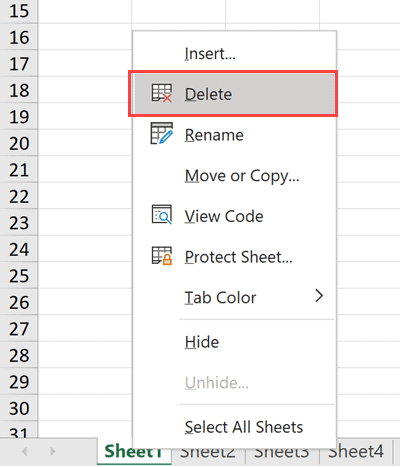5 Quick Tips to Delete Unused Excel Sheets in 2013

If you're working with large Excel workbooks in Excel 2013, you might find yourself needing to declutter by deleting unused sheets. While it might seem like a straightforward task, there are several methods you can employ to make this process more efficient. Here are five quick tips to streamline your workbook management in Excel 2013.
1. Right-Click and Delete


The most straightforward method to delete a sheet is by using the context menu:
- Right-click on the tab of the sheet you want to delete.
- Select Delete from the menu that appears.
- Confirm your action by clicking Delete in the dialog box.
⚠️ Note: Be cautious when deleting sheets to avoid accidental deletion of important data.
2. Use the Ribbon Command

Another quick method involves using the Excel Ribbon:
- Select the sheet tab you wish to delete.
- Go to the Home tab on the Ribbon.
- Click on Delete under the Cells group, then choose Delete Sheet.
- Confirm the action in the prompt.
3. Keyboard Shortcut

For those who prefer using keyboard shortcuts for efficiency:
- Click on the tab of the sheet you want to delete.
- Press ALT + E, then L followed by D.
- Confirm the deletion when prompted.
Keyboard shortcuts can save time, especially if you’re deleting multiple sheets or navigating through a large workbook.
4. VBA Macro to Delete Sheets

For those comfortable with VBA:
Sub DeleteSheets()
Dim ws As Worksheet
For Each ws In ThisWorkbook.Worksheets
If ws.Name <> “Sheet1” Then
Application.DisplayAlerts = False
ws.Delete
Application.DisplayAlerts = True
End If
Next ws
End Sub
- Press ALT + F11 to open the VBA editor.
- Insert a new module and paste the above code.
- Run the macro by pressing F5 or by assigning it to a button.
This script will delete all sheets except “Sheet1”, which acts as a safeguard.
5. Group Delete Multiple Sheets

If you need to delete several sheets at once:
- Hold down the Ctrl key to select multiple sheets.
- Right-click on any of the selected tabs and choose Delete.
- Confirm your action in the prompt that appears.
| Method | Use Case |
|---|---|
| Right-Click and Delete | For single sheet deletion |
| Ribbon Command | When navigating through Ribbon is preferred |
| Keyboard Shortcut | To quickly delete without mouse interaction |
| VBA Macro | When deleting multiple or specific sheets programmatically |
| Group Delete | When multiple sheets need to be deleted together |

These tips can significantly simplify workbook management, making your Excel experience smoother and more productive. Remember that while these methods are efficient, always double-check which sheets you are deleting to avoid losing important data.
To wrap up, cleaning up an Excel workbook by deleting unused sheets can help reduce file size, improve performance, and make your spreadsheets easier to navigate. Whether you prefer the simplicity of a right-click, the command of the Ribbon, the speed of a keyboard shortcut, or the automation of VBA, Excel 2013 provides multiple paths to streamline your work.
Can I recover a deleted sheet in Excel?

+
Unfortunately, once a sheet is deleted in Excel, it cannot be easily recovered unless you have a backup or previously saved the file before the deletion. Always make sure to save your work frequently to mitigate data loss.
How can I avoid accidentally deleting a sheet?

+
You can protect your sheets to prevent accidental deletions. Go to Review > Protect Sheet, and uncheck the option for Delete sheets. This will require a password to delete the sheet.
Is there a way to delete hidden sheets?

+
Yes, you can unhide the sheets first or directly use VBA to delete hidden sheets by modifying the script provided in the ‘VBA Macro to Delete Sheets’ section to include hidden sheets in its scope.



